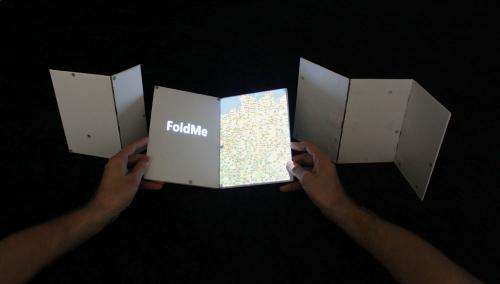February 4, 2012 report
Fold-it computer action set for Canada conference (w/ video)

(PhysOrg.com) -- What nonsense, sitting in front of one, single display screen and struggling with a split-screen view of multiple-sites plus data entry or word processing. Is this the way it has to be for doing papers, writing reports, presenting detailed stats, and collaborating with others? In 2012, the single-screen sit-down is the common user experience, not nonsense, but a concept presentation at an upcoming conference in Canada could change expectations for good.
Researcher Jurgen Steimle has devised a two-sided, foldable touchscreen concept that offers a book-like rather than one-screen user experience. Steimle and Mohammadreza Khalilbeigi, Roman Lissermann, and Wolfgang Kleine will present their research titled FoldMe: Interacting with Double-sided Foldable Displays at the Tangible, Embedded and Embodied Interaction (TEI 2012) Conference starting February 19 to February 22 in Kingston, Ontario.
Describing the project, the authors say that “We present a novel device concept that features double-sided displays which can be folded using predefined hinges. The device concept enables users to dynamically alter both size and shape of the display and also to access the backside using fold gestures.”
The video says it all, in terms of what the authors propose as interaction techniques. A tablet with spring-loaded hinges is folded like a book or a pamphlet. The user can make use of a single display screen or a front cover screen, two inside cover screens, or pamphlet-like fold arrangements. The act of folding is clever enough to be thought of as the art of folding, as the user has options either to use it as a single display tablet screen or bend it in the middle like a book for two-display mode and other types of folds.
Projection techniques that enable the concept to work involve six overhead infrared cameras and two high-definition digital projectors.
Watching the video it also becomes apparent that researchers like Steimle and his team are focused on raising the experience of computing for mobile knowledge workers. They have in mind freeing up the user experience for those who interact with data all the time, in accessing, parking, referring to, writing about, editing, sharing comments on, information. The video shows the tablet folding and offering interaction possibilities for writing and also demonstrates interactions ideal for visual displays and design.
Steimle is visiting assistant professor in the Fluid Interfaces Group at the MIT Media Lab. Up to December last year, he headed the Tangible Interaction area at the Telecooperation Lab at the Technical University of Darmstadt, Germany.
Steimle has been interested in different types of flexible displays, including rollable and foldable displays. “We believe that in the near future many portable devices will have resizable displays,” he said. “This will allow for devices with a very compact form factor, which can unfold into a large display when needed.“
In the coming weeks, the touchscreen display presentation, once revealed at the TEI show, will no doubt be right at home. The theme of this year’s conference is “fold unfold.”
More information:
ambient.media.mit.edu/people/j … nt/flexdisplays.html
www.tk.informatik.tu-darmstadt … -interaction/foldme/
© 2011 PhysOrg.com




















